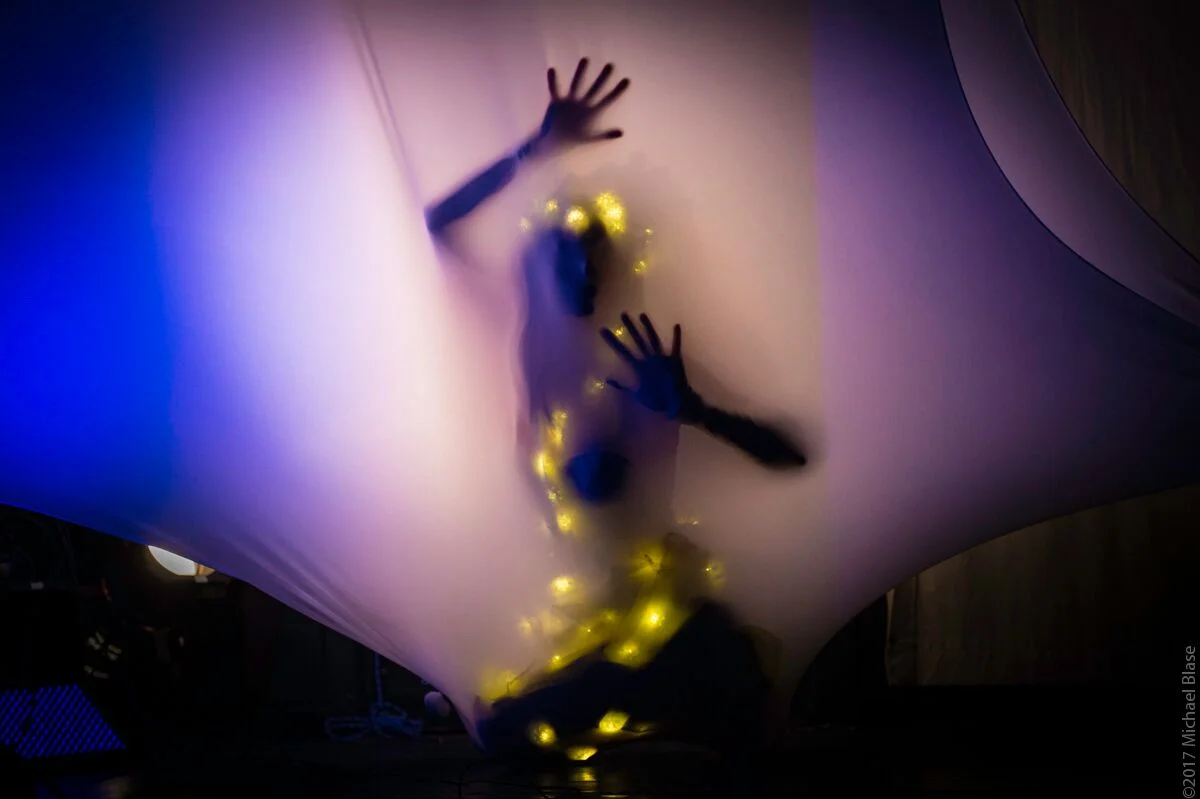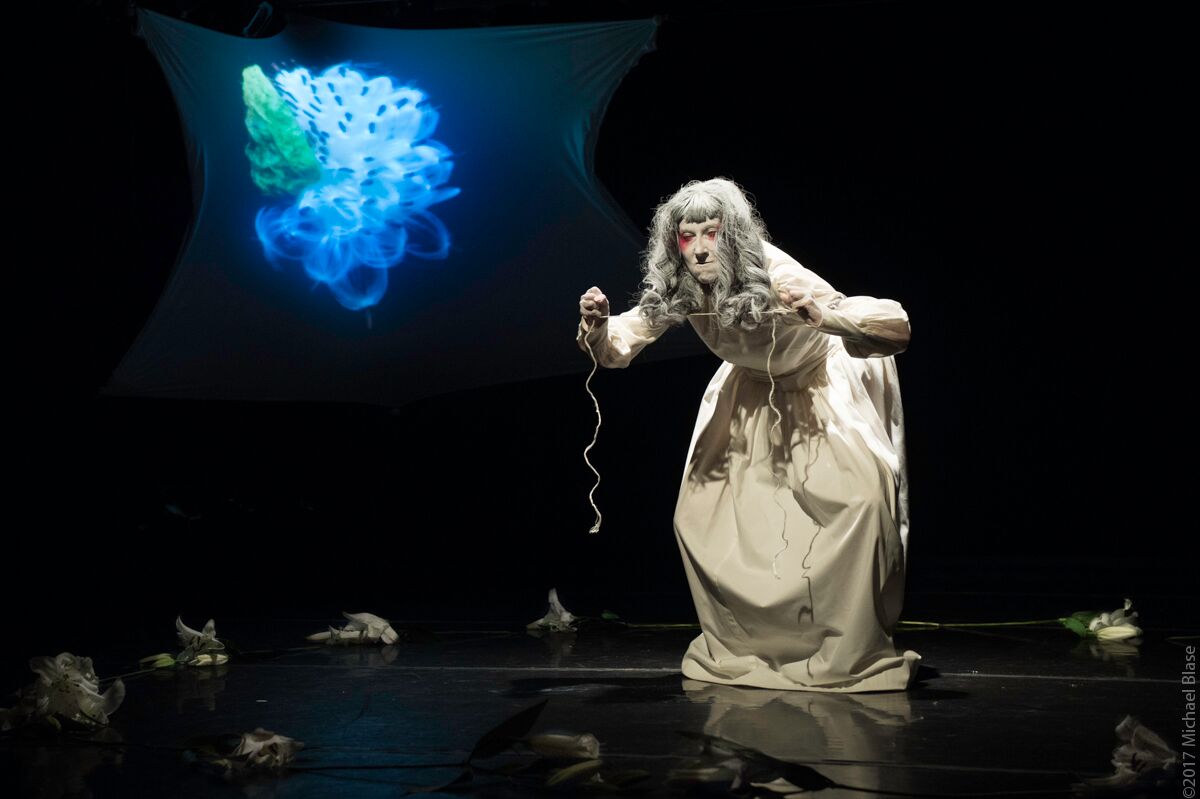Triskelion Arts presents, in association with Vangeline Theater and The New York Butoh Institute
Tetsuro Fukuhara - Photo by Michael Blase
Vangeline- Photo by Michael Blase
"Flower - Secret"
an evening of Butoh solos with Butoh Master Tetsuro Fukuhara and Vangeline
Featuring butoh dancer Sindy Butz
Petal photography by Tal Shpantzer
Friday November 17 at 8pm
Saturday November 18 at 8pm
Sunday November 19 at 7pm
at Triskelion Arts, 106 Calyer Street, Brooklyn, NY 11222
Tickets: $18 in advance/ $22 at the door
BUY TICKETS HERE: https://www.eventbrite.com/e/triskelion-arts-presents-vangeline-theater-tickets-35983374241
Sindy Butz- Photo by Michael Blase
Tetsuro Fukuhara and Vangeline the second and third generations of Butoh, a physical symbol of evolution— teacher to student, man to woman, past to future. For this collaboration, the artists will work together to share their artmaking practices to create new work. Fukuhara will perform in a large suspended hollow tube. Vangeline will create a new “Dance of Darkness” work. Through this collaborative performance, the artists seek to reveal the way the art form has grown and shifted, and how individuals are encouraged to adapt the Butoh, ensuring the style is reflective and responsive.
Over the past 60 years, Butoh has become a universal and international movement language. Developed in post-World War II Japan, the minimalist avant-garde dance form has grown, evolved, and travelled worldwide; Butoh is taught and performed across the United States, in Europe, Africa, and Latin America. While the form has its roots in Japan, there are Butoh artists of all cultures, backgrounds, and ethnicities continuing its legacy into the 21st century.
The performance premiere will take place November 17-19 at Triskelion Arts in Brooklyn. In advance of the performances, several community engagement and educational activities will occur to build audience and interest, including a a symposium with Fukuhara and Vangeline and a number of other experts at Howl! Arts in Manhattan (November 13, 2017).
Tetsuro Fukuhara, President of Tokyo Space Dance, is a second-generation movement artist of “Improvisation Butoh.” Tetsuro’s studied under Akira Kasai, and Butoh founders Kazuo Ohno, and Tatsumi Hijikata. At 68, Tetsuro represents the oldest generation of Japanese Butoh. His style of “New Butoh Space Dance” is a way to socialize Butoh for the general public, bringing together elements of dance, architecture, information, and design.
Vangeline is an internationally-acclaimed French-born New York City-based Butoh choreographer and is regarded widely as an expert in her field in the United States. She is the founder of the New York Butoh Institute and Artistic Director of the Vangeline Theater, an all-female dance company firmly rooted in the tradition of Japanese Butoh while carrying it into the 21st century. Vangeline’s socially conscious performances tie together Butoh and activism. Her performances have dealt with subjects as varied as feminism, climate change, war and perceptions of gender.
A native of Germany, SINDY BUTZ grew up in the suburbs of East Berlin and has started her dance education in Ballet, Dance Theater and Folk Dance at the age of 6 in the Dance Theater Strausberg under Nora Jarchow-Dürrenfeld/ Palucca School. She has been performing since the age of 9. After receiving her Master's Degree in Visual Art/AKI Enschede (NL) and Art Science/ UdK Berlin (DE), she focused on Performance Art, Sculptural Installation and Butoh Dance. In 2009 equipped with the DAAD research grant for the New York University, she moved to New York. Since 2010 she has been a principal member for the Vangeline Theater. She has performed and exhibited solo projects nationally and internationally.
Tal Shpantzer is an award-winning Brooklyn-based fine art photographer, recognized both internationally and nationally. Tal Shpantzer’s petal portraits, are striking in their apparent simplicity and richness of detail. The portraits both engage with and challenge our traditional notions of flowers as symbols. “My principal interest,” Shpantzer says, “is exploring moments that are undefined on sensory, emotional, and psychological levels. I am fascinated by the dialogue that arises from and intersects with expressions of uncertainty and states of transience. What I see may appear to be the simplest of moments and yet reveal otherwise unknown complexities or evoke imagined histories and hidden truths.”
VANGELINE THEATER aims to preserve the legacy and integrity of Japanese Butoh, while carrying the art form well into the future. The unique art of Butoh originated in post-World War II Japan as a reaction to the loss of identity caused by the westernization of Japanese culture, as well as a realization that ancient Japanese performing traditions no longer spoke to a contemporary audience. One of the major developments in contemporary dance in the latter half of the 20th century, Butoh combines dance, theater, improvisation and influences of Japanese traditional performing arts to create a unique performing art form that is both controversial and universal in its expression.The Vangeline Theater is home to the New York Butoh Institute, dedicated to the advancement of Butoh in the 21st century.
This program is supported, in part, by public funds from the New York City Department of Cultural Affairs in partnership with the City Council as well as the New York State Council on the Arts with the support of Governor Andrew M. Cuomo and the New York State Legislature.
REVIEW OF TETSURO FUKUHARA's SOLO PERFORMANCE IN WARSAW- 2016"
"Warsaw hosted the director of Tokyo Space Dance and Space Museum - Tetsuro Fukuhara. The visit of the Japanese choreographer and dancer was accompanied by a remarkable performance of "Strange Fruit".
Tetsuro Fukuhara belongs to the second generation of Butoh artists. At the beginning he worked with Japanese performer Tatsumi Hijikata and in 1983 took part in his performance of "History of seven herbs." He learned the art of Butoh improvisation at the same time from Akira Kasai. His performances in Paris and Berlin in 1990 opened the door to an international career. Tetsuro Fukuhara’s visit in Warsaw is associated with the presentation of the concept of New Butoh Space Dance as part of the international route from Kampala to Istanbul. In addition to the performance, the artist also prepared Butoh dance workshops for children and adults. Classes with the dancer offer the perfect opportunity to experience the philosophy of the Butoh master himself.
But what is Butoh? It is primarily an alternative to the conservative school of Japanese theater. Butoh was a kind of manifesto against Western influences that in the second half of the twentieth century, massively trying to conquer the Japanese culture. In Butoh,
learned perfection goes by the wayside. "Dance of darkness" focuses more on the steps and movement rather than dance. Therefore, it is said that it is an art more than dance. It does not have anything planned in advance and choreography or a particular technique, because at its core the belief that traditional and rhythmic steps disturb the discovery of the internal energy of the dancer.
Slow motion manipulates and recreates reality. Here, every little gesture is exaggerated, even sometimes you get the impression of a whole grotesque performance. However, with every movement, the performer's body departs, even dissolves in its form. Although it is a movement coming from inside, his steps guided by
the emotions come from the outside. This is not only a spiritual experience or feeling entity. The dancer can see him/herself from the inside, but looks at him/herself from the outside - as an observer.
Butoh cannot be called trance, because the senses of the artist during the show must be all the time focused on the signals sent by the brain and stimuli coming from the surrounding reality. The magic of the Japanese "dance of darkness" is released when
the streams coming from the subconscious psyche are able to set in motion our bodily matter. Only then, can one talk about reaching the state of unity of body and soul.
"Strange Fruit" is a choreography, in which something is born to die in a moment. Every gesture is a movement not to repeat. Each outside made up for something special and unique. For something, for a moment, to lose its sense. White costume and makeup
performer removes all the characteristics of gender, race or age of man. Tetsuro Fukuhara created thus a universal show: the story could take place anywhere in the world regardless of time and cultural identity. He treated the body as a story and not just as a tool to express it. Each sequence of steps link to the past and raises the primal instincts. The body slowly comes to life, to find their destiny in the contemporary world.
Lives his catharsis, which washes away the dirt from it and toxins contaminated civilization. Dancing modernity with its every step proves the fragility of the body, which sooner or later will be with all kinds of deformations.
"Strange fruit" fits perfectly well in the Japanese mentality, according to which life and death belong to the cosmic cycle. The beauty of this natural order is manifested in its transience, the reproducibility, and transience. Although white in Japanese tradition is a symbol of mourning, in the case of this project, I think that it was also to emphasize the inner glow that Fukuhara’s body exudes in the final scene of the play. The metaphysical trip to the sources of human existence audience accompanied by an unusually raised instrumental music.
Experience of Butoh is always a very personal experience, which depends on our individual sensitivity. The techniques of this dance is not possible to teach or work, you have to feel it in the back of your mind and released by the body. The show 'Strange Fruit' was shown on October 29 in the Capital Theatre Institute.
2016-11-02 09:08 BY IWONA BURZYŃSKA
Kultura Online
http://kulturaonline.pl/dziwny,owoc,mistrz,tanca,butoh,tetsuro,fukuhara,w,warszawie,relacja,tytul,artykul,2
6917.html






